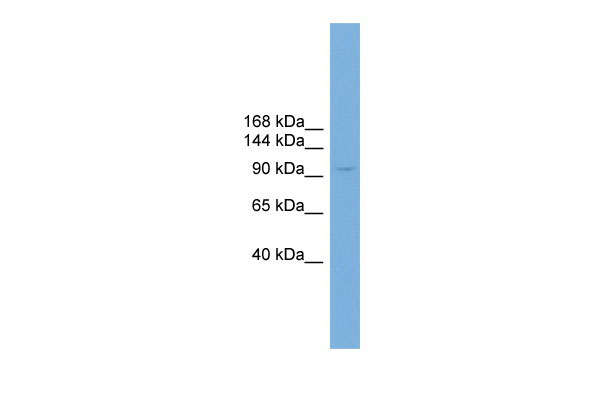PIWIL4 antibody - N-terminal region
Rabbit Polyclonal Antibody
- SPECIFICATION
- CITATIONS
- PROTOCOLS
- BACKGROUND

Application
| WB |
|---|---|
| Primary Accession | Q7Z3Z4 |
| Other Accession | NM_152431, NP_689644 |
| Reactivity | Human |
| Predicted | Human |
| Host | Rabbit |
| Clonality | Polyclonal |
| Calculated MW | 96 KDa |
| Gene ID | 143689 |
|---|---|
| Alias Symbol | DKFZp686P01248, FLJ36156, HIWI2, MIWI2 |
| Other Names | Piwi-like protein 4, PIWIL4, HIWI2, PIWI |
| Format | Liquid. Purified antibody supplied in 1x PBS buffer with 0.09% (w/v) sodium azide and 2% sucrose. |
| Reconstitution & Storage | Add 50 ul of distilled water. Final anti-PIWIL4 antibody concentration is 1 mg/ml in PBS buffer with 2% sucrose. For longer periods of storage, store at 20°C. Avoid repeat freeze-thaw cycles. |
| Precautions | PIWIL4 antibody - N-terminal region is for research use only and not for use in diagnostic or therapeutic procedures. |
| Name | PIWIL4 |
|---|---|
| Synonyms | HIWI2, PIWI |
| Function | Plays a central role during spermatogenesis by repressing transposable elements and preventing their mobilization, which is essential for the germline integrity (By similarity). Acts via the piRNA metabolic process, which mediates the repression of transposable elements during meiosis by forming complexes composed of piRNAs and Piwi proteins and governs the methylation and subsequent repression of transposons (By similarity). Directly binds piRNAs, a class of 24 to 30 nucleotide RNAs that are generated by a Dicer-independent mechanism and are primarily derived from transposons and other repeated sequence elements (By similarity). Associates with secondary piRNAs antisense and PIWIL2/MILI is required for such association (By similarity). The piRNA process acts upstream of known mediators of DNA methylation (By similarity). Does not show endonuclease activity (By similarity). Plays a key role in the piRNA amplification loop, also named ping-pong amplification cycle, by acting as a 'slicer-incompetent' component that loads cleaved piRNAs from the 'slicer-competent' component PIWIL2 and target them on genomic transposon loci in the nucleus (By similarity). May be involved in the chromatin-modifying pathway by inducing 'Lys-9' methylation of histone H3 at some loci (PubMed:17544373). In addition to its role in germline, PIWIL4 also plays a role in the regulation of somatic cells activities. Plays a role in pancreatic beta cell function and insulin secretion (By similarity). Involved in maintaining cell morphology and functional integrity of retinal epithelial through Akt/GSK3alpha/beta signaling pathway (PubMed:28025795). When overexpressed, acts as an oncogene by inhibition of apoptosis and promotion of cells proliferation in tumors (PubMed:22483988). |
| Cellular Location | Nucleus. Cytoplasm Note=Probable component of the meiotic nuage, also named P granule, a germ-cell-specific organelle required to repress transposon activity during meiosis. PIWIL2/MILI is required for nuclear localization (By similarity). {ECO:0000250|UniProtKB:Q8CGT6} |
| Tissue Location | Ubiquitously expressed (PubMed:25038252, PubMed:17544373, PubMed:28025795, PubMed:28711973, PubMed:22483988) Detected in retina, retinal pigment epithelia cells (RPE) (at protein level) (PubMed:28025795). |

Thousands of laboratories across the world have published research that depended on the performance of antibodies from Abcepta to advance their research. Check out links to articles that cite our products in major peer-reviewed journals, organized by research category.
info@abcepta.com, and receive a free "I Love Antibodies" mug.
Provided below are standard protocols that you may find useful for product applications.
References
Sasaki T.,et al.Genomics 82:323-330(2003).
Ota T.,et al.Nat. Genet. 36:40-45(2004).
Bechtel S.,et al.BMC Genomics 8:399-399(2007).
Sugimoto K.,et al.Biochem. Biophys. Res. Commun. 359:497-502(2007).
If you have used an Abcepta product and would like to share how it has performed, please click on the "Submit Review" button and provide the requested information. Our staff will examine and post your review and contact you if needed.
If you have any additional inquiries please email technical services at tech@abcepta.com.













 Foundational characteristics of cancer include proliferation, angiogenesis, migration, evasion of apoptosis, and cellular immortality. Find key markers for these cellular processes and antibodies to detect them.
Foundational characteristics of cancer include proliferation, angiogenesis, migration, evasion of apoptosis, and cellular immortality. Find key markers for these cellular processes and antibodies to detect them. The SUMOplot™ Analysis Program predicts and scores sumoylation sites in your protein. SUMOylation is a post-translational modification involved in various cellular processes, such as nuclear-cytosolic transport, transcriptional regulation, apoptosis, protein stability, response to stress, and progression through the cell cycle.
The SUMOplot™ Analysis Program predicts and scores sumoylation sites in your protein. SUMOylation is a post-translational modification involved in various cellular processes, such as nuclear-cytosolic transport, transcriptional regulation, apoptosis, protein stability, response to stress, and progression through the cell cycle. The Autophagy Receptor Motif Plotter predicts and scores autophagy receptor binding sites in your protein. Identifying proteins connected to this pathway is critical to understanding the role of autophagy in physiological as well as pathological processes such as development, differentiation, neurodegenerative diseases, stress, infection, and cancer.
The Autophagy Receptor Motif Plotter predicts and scores autophagy receptor binding sites in your protein. Identifying proteins connected to this pathway is critical to understanding the role of autophagy in physiological as well as pathological processes such as development, differentiation, neurodegenerative diseases, stress, infection, and cancer.


